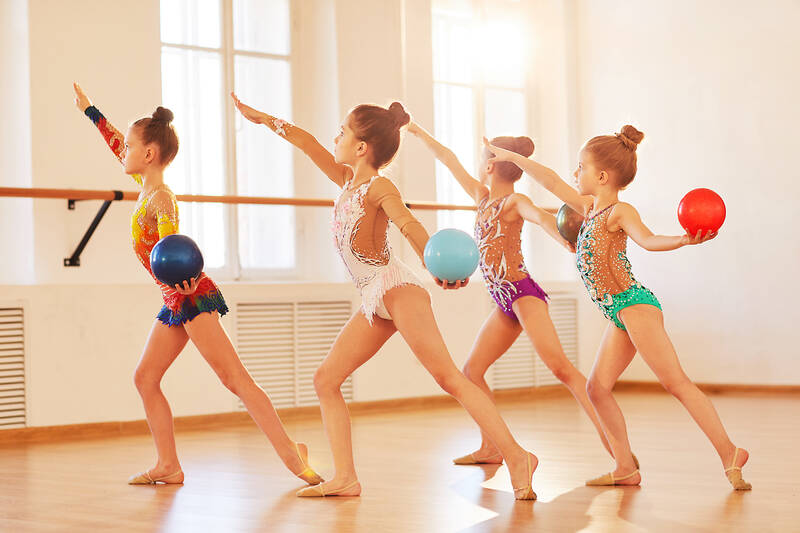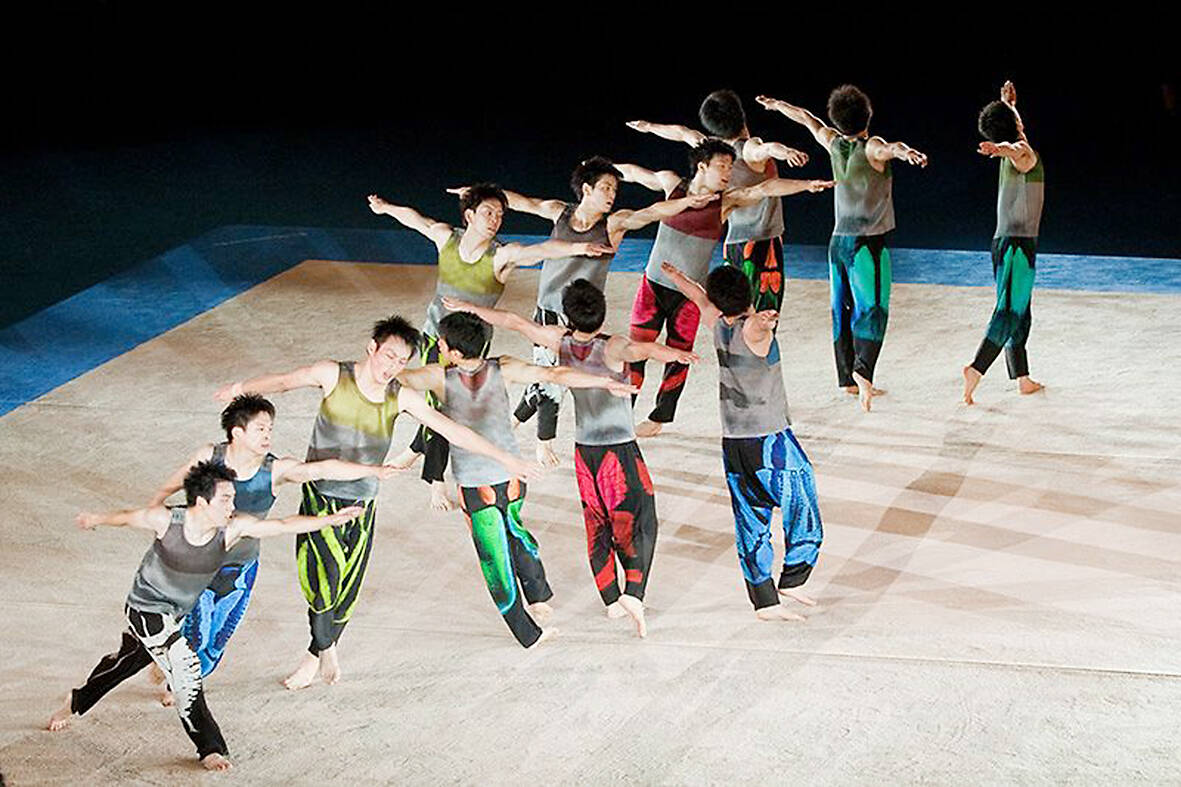You might have seen athletes gracefully bending and leaping in rhythm with melodies. This is “rhythmic gymnastics,” a sport often mistaken for artistic gymnastics. However, the two are distinct in focus and presentation.
Artistic gymnastics focuses on strength, flexibility, and balance, with athletes performing solo on various equipment. They are scored based on the difficulty of their movements, their execution of certain skills on each apparatus, and their ability to combine multiple skills into different movements. Rhythmic gymnastics, on the other hand, emphasizes style and presentation, with athletes often performing in teams. Moving in harmony with music, they use different items like balls, hoops, ribbons, and clubs. This creates a performance that looks like a dance but with athletic skills.
Another significant difference between artistic and rhythmic gymnastics is that only women are allowed to compete in major international rhythmic gymnastics events. This has been the case since the sport’s beginning. Rhythmic gymnastics dates back to 19th-century Europe and started to gain international popularity during the mid-20th century. By the 1980s, it was formally included in the Olympic Games for women. Although the sport is largely associated with female athletes, there are also men who practice rhythmic gymnastics. However, male versions of the sport have yet to receive official recognition.

Photo: AdobeStock I 照片: AdobeStock
Currently, two styles of male rhythmic gymnastics are on the rise. One of them, known as the Japanese school, is characterized by dynamic and powerful tumbling elements. While group routines don’t usually use equipment, individual routines use clubs, ropes, double rings, and sticks. The Spanish school is more similar to traditional rhythmic gymnastics and has developed alongside it. Its rules mirror women’s international rhythmic gymnastics. Male rhythmic gymnastics might not be represented internationally yet, but its current growth levels suggest a promising future for the sport.
你可能見過運動員隨著旋律優雅地照著節奏彎曲、跳躍。這就是韻律體操,一項常被誤認為是競技體操的運動。然而,兩者在著重之處和表現形式上截然不同。
競技體操注重力量、身體柔軟度跟平衡性,運動員在各種器材上單獨表演。他們的評分是根據動作的難度、在每個器材上某些技巧的執行度,以及將多種技巧組合成不同動作的能力而來。另一方面,韻律體操則強調風格和呈現,運動員經常以團隊形式表演。他們隨著音樂和諧一致地移動著,使用不同的物品,如球、環、彩帶和棒子。這創造了一種看起來像是舞蹈但具有運動技巧的表演。

Photo: AdobeStock I 照片: AdobeStock
競技體操和韻律體操之間的另一個顯著區別是,只有女性才可以參加主要的國際韻律體操賽事。自從這項運動誕生以來,情況就一直是如此。韻律體操可追溯至十九世紀的歐洲,並在二十世紀中葉開始在國際上流行。到了1980年代,韻律體操正式列入女子奧運比賽項目。儘管這項運動主要與女性運動員有關,但也有男性在練習韻律體操。然而,這項運動的男性版本尚未獲得官方認可。
目前,兩種流派的男子韻律體操正興起。其中一種被稱為日本流派,其特色是動感而有力的翻滾元素。雖然團體整套的動作不常使用器材,但個人整套的動作會使用棒、繩、雙環和棍。西班牙流派與傳統的韻律體操比較相近,並與其一同發展。其規則跟女子國際韻律體操很像。男子韻律體操可能還無法列入國際賽事,但其目前的增長程度顯示了這項運動的未來大有可為。
What Did You Learn?
1. From (A) to (F) below, choose the descriptions that are true
about artistic gymnastics.(多選題)
(A) It features athletes performing alone.
(B) It can be traced back to the 20th century.
(C) It was added to the Olympic Games in the 1980s.
(D) It’s a new sport that rose in popularity a decade ago.
(E) It requires athletes to be balanced, flexible, and strong.
(F) It was invented in Japan and quickly spread across Spain.
2. 請從文章中找出最適當的單詞(word)填入下列句子空格中,並視句型結構需要做適當的字形變化,使句子語意完整、語法正確,並符合全文文意。(填充)
While rhythmic gymnastics is mainly seen as a sport for female athletes, men also participate in it. Nevertheless, the male versions of the sport have not been officially _____.
3. How does the team event in Japanese men’s rhythmic gymnastics differ from the individual event?
4. Why is the Spanish school of male rhythmic gymnastics said to resemble traditional rhythmic gymnastics more closely?
參考答案
1. A、E
2. recognized
3. Group routines / Athletes don’t usually use equipment /
items / apparatuses.
4. Its rules mirror women’s international rhythmic gymnastics.
Word in Use
1. gracefully adv. 優雅地
The ballerina moved gracefully across the stage.
那個芭蕾舞者在舞臺上優雅地移動著。
2. leap vi. 跳躍
The cat leaped onto the counter to catch the mouse.
那隻貓跳到櫃檯上要抓那隻老鼠。
3. presentation n. 表現,呈現
The presentation of the data was clear and concise.
那些資料的呈現方式非常簡潔明瞭。
4. flexibility n. 身體柔軟度
Yoga helps improve flexibility by stretching muscles.
透過伸展肌肉,瑜珈有助於提升身體柔軟度。
5. multiple a. 多種的,眾多的
After receiving multiple job offers, I carefully compared
them. 收到多個工作機會後,我審慎地比較了那些機會。
Practical Phrases
1. in rhythm 照著節奏
rhythm n. 節奏
The drummer keeps the band in rhythm throughout the entire song.
鼓手讓樂團整首歌都照著節奏走。
2. mistake A for B 把 A 誤認為 B
In the dim light, Wendy mistook a stranger for her friend.
昏暗燈光下,溫蒂把一位陌生人誤認成她的朋友。
3. in harmony 和諧地
harmony n. 和諧
The colors in the painting were in harmony, creating a
pleasing composition.
那幅畫的顏色很和諧,創造出一種美妙的構圖。
4. have yet to V 尚未……
The project hasn’t progressed as it has yet to receive
approval from the committee.
該計畫沒有進展,因為尚未得到委員會的許可。
5. on the rise 崛起,變得成功
Electric vehicles are on the rise due to growing
environmental concerns.
因環境意識抬頭,電動車崛起。
聽文章朗讀及講解: https://ivy.pse.is/455bfu
本文出自常春藤解析英語雜誌: www.ivy.com.tw

In an effort to fight phone scams, British mobile phone company O2 has introduced Daisy, an AI designed to engage phone con artists in time-wasting conversations. Daisy is portrayed as a kindly British granny, exploiting scammers’ tendency to target the elderly. Her voice, based on a real grandmother’s for authenticity, adds to her credibility in the role. “O2” has distributed several dedicated phone numbers online to direct scammers to Daisy instead of actual customers. When Daisy receives a call, she translates the scammers’ spoken words into text and then responds to them accordingly through a text-to-speech system. Remarkably, Daisy

Bilingual Story is a fictionalized account. 雙語故事部分內容純屬虛構。 Emma had reviewed 41 resumes that morning. While the ATS screened out 288 unqualified, she screened for AI slop. She could spot it a mile away. She muttered AI buzzwords like curses under her breath. “Team player.” “Results-driven.” “Stakeholder alignment.” “Leveraging core competencies.” Each resume reeked of AI modeling: a cemetery of cliches, tombstones of personality. AI wasn’t just changing hiring. It was draining the humanity from it. Then she found it: a plain PDF cover letter. No template. No design flourishes. The first line read: “I once tried to automate my

Every May 1, Hawaii comes alive with Lei Day, a festival celebrating the rich culture and spirit of the islands. Initiated in 1927 by the poet Don Blanding, Lei Day began as a tribute to the Hawaiian custom of making and wearing leis. The idea was quickly adopted and officially recognized as a holiday in 1929, and leis have since become a symbol of local pride and cultural preservation. In Hawaiian culture, leis are more than decorative garlands made from flowers, shells or feathers. For Hawaiians, giving a lei is as natural as saying “aloha.” It shows love and

1. 他走出門,左右看一下,就過了馬路。 ˇ He walked outside, looked left and right, and crossed the road. χ He walked outside and looked left and right, crossed the road. 註︰並列連接詞 and 在這句中連接三個述語。一般的結構是 x, y, and z。x and y and z 是加強語氣的結構,x and y, z 則不可以。 2. 他們知道自己的弱點以及如何趕上其他競爭者。 ˇ They saw where their weak points lay and how they could catch up with the other competitors. χ They saw where their weak points lay and how to catch up with the other competitors. 註:and 一般連接同等成分,結構相等的單詞、片語或子句。誤句中 and 的前面是子句,後面是不定詞片語,不能用 and 連接,必須把不定詞片語改為子句,and 前後的結構才相等。 3. 她坐上計程車,直接到機場。 ˇ She took a cab, which took her straight to the airport. ˇ She took a cab and it took her straight